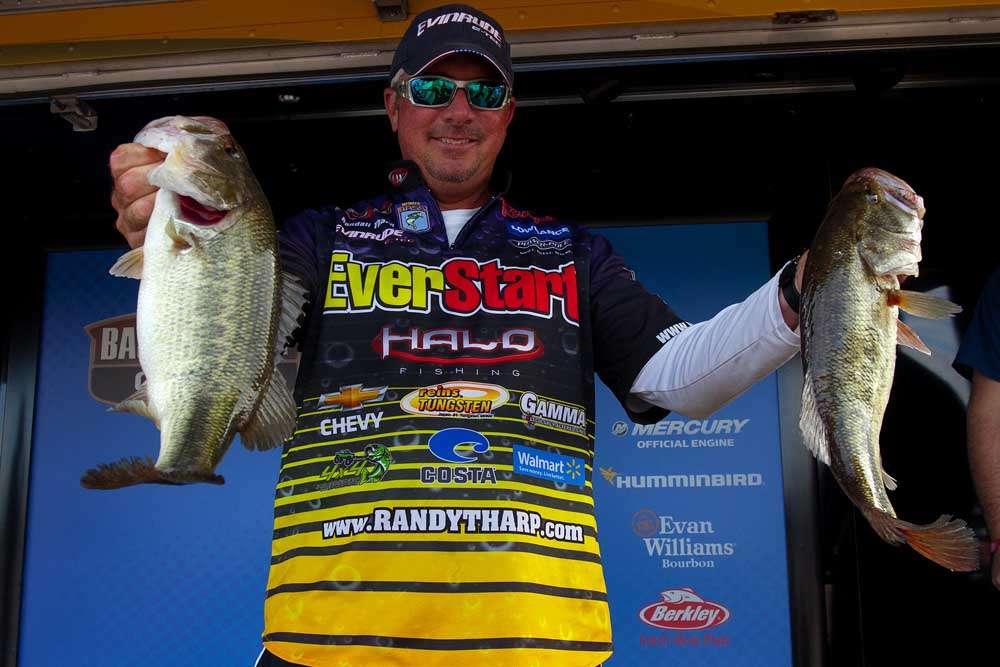
Just about everyone expects the lipless crankbait to be in play during the GEICO Bassmaster Classic presented by Diet Mountain Dew and GoPro on Lake Guntersville.
“It’s no secret that you should be throwing rattling baits during springtime on Guntersville,” said Classic contender Randall Tharp.
He should know. The former Alabama resident built his career fishing the famous bass lake.
“That’s where my tournament career got cranked up, and I’ve won several events at all competition levels there,” he offered.
Tharp says lipless lures played huge roles in many of those wins and are lures that anglers need to utilize on Guntersville during the prespawn.
“I doubt if there is a better prespawn lure for fishing anywhere in the country,” he said. “If I only had one bait that time of year to use on a grass lake — which Guntersville is — it would be a lipless crankbait.”
When the bass are aggressive, he added, you don’t need any special skills or tactics. However, you can hook and land more bass by implementing these strategies during the prespawn:
Fish near spawning areas
The bass have spawning on their minds at the end of winter and long before they swarm the flats in the spring. They will be migrating to those areas.
“They start transitioning from deeper water to the flats, so look for places where you can intercept them, like points, main lake grass beds or grass on points,” Tharp explained. “Creek channels are obvious pathways for them to use that time of year.”
On Guntersville, Tharp starts with main lake grass beds then systematically works his way back into the creeks until he locates bass concentrations.
“Guntersville is unique in that bass spawn on the main lake as well as in the backs of creeks,” he noted.
Nearby deep water is a necessity, he insisted, but water depth is relative. It could be as little as a 3-foot drop along a flat.
“Even if they are shallow, they’ll be close to some kind of drop for security,” he explained. “If a weather front comes in they’ll slip off the ledges, and when the weather starts to warm, they’ll move shallower.”
Experiment with baits
Tharp advises anglers to not get hung up on one model of lipless bait. He has three favorites, each for specific conditions, but notes that “new” baits are worth trying.
“It seems that there is always a new bait out there that gets hot for a while; maybe the fish get accustomed to seeing/hearing the popular models and are less gun-shy of a new sound,” he explained. “So if you’re on a lake that gets a lot of pressure from the same brand or model, try showing them something different.”
In many instances, he’ll have three baits tied to rods: a 1/2-ounce Cordell Spot for when the fish are real sluggish but in ultra-shallow water; a 1/2-ounce Strike King Red Eye Shad for 3-6 feet or deeper water and for yo-yoing; and a 5/8-ounce Yo-Zuri Rattling Vibe for fishing deeper water and when the shad are larger.
“The Spot is a lighter 1/2-ounce than the Red Eye, so you can fish it shallower,” he offered. “Pay attention to how each brand performs so you can choose one that fits the situation appropriately.”
Tharp recalled a tournament when he caught 27 pounds on lipless baits from 2 feet of water when the water temp was 36 degrees.
“It was a day when you would have sworn they wouldn’t chase a bait, especially a rattling bait,” he described. “I was holding the tip high and barely turning the handle so the bait was dragging through grass stubble on the bottom.”
There are days when burning the bait to the boat works well, but more often than not, a steady retrieve that ticks the tops of grass works best.
In deeper water, he likes to yo-yo the bait, lifting it and letting it fall like one would a plastic worm.
“Most strikes occur on the fall, and the Red Eye is best for that because it falls upright and wobbles,” Tharp explained.
Rig properly
Tharp believes he has the perfect setup for lipless lures. It consists of a 7-4 medium heavy Halo Cranking Rod and a Shimano Core 6.2:1 baitcaster spooled with 30-pound Gamma Torque braided line. He ties his lure directly to braid.
“The rod is soft enough to absorb the shock while the no-stretch line allows me to snap the lure out of the grass with minimal effort,” he described. “When I went to that setup, my hook/land ratio improved considerably and it gave me the strength to play the bigger fish.”
Like the kind Classic contenders hope to be catching at Guntersville.





